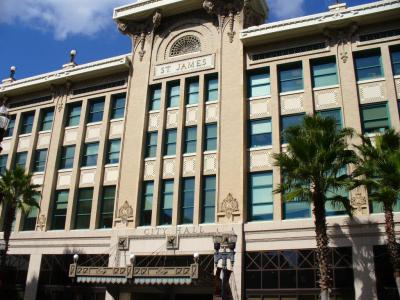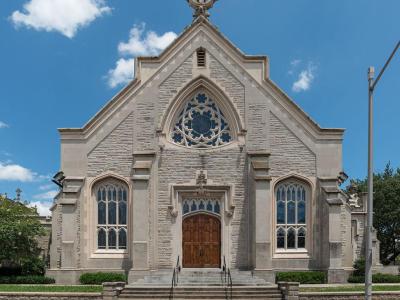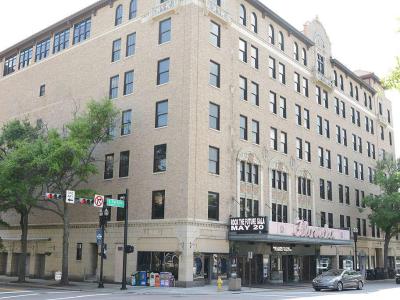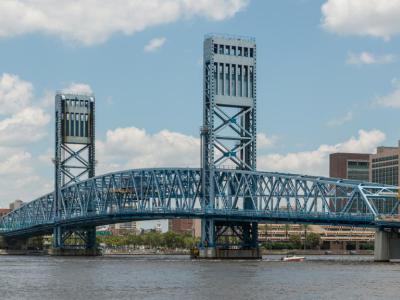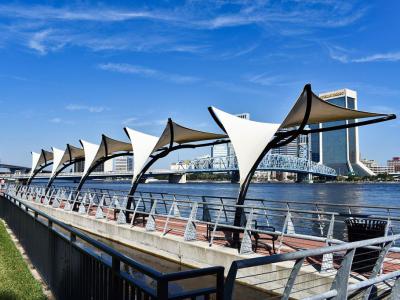Audio Guide: Jacksonville Introduction Walking Tour (Self Guided), Jacksonville
Jacksonville, Florida-a place where size does matter. Stretching its way into the record books as the largest city by area in the continental U.S., Jacksonville hugs the northeastern edge of the Sunshine State, where the St. Johns River meanders lazily toward the Atlantic.
Long before traffic jams and beach selfies, the Timucua people called this area home. Then came the usual suspects: Spanish explorers, British colonists, and finally, Americans with a flair for naming things after former presidents – this time, step in Andrew Jackson. Officially founded in 1832, Jacksonville has seen its share of plot twists, from Civil War skirmishes to booming railroads and a timber rush that practically built half the town. Then came the Great Fire of 1901, which charred the city but also lit the spark for a bold architectural revival.
Fast-forward to the 20th century, and Jacksonville found its groove as a financial, cultural, and political hub. It marched through the civil rights era, then pulled off a bureaucratic magic trick in 1968 by merging its city and county governments-because why have two headaches when one will do?
Today, Jacksonville blends old soul and new energy. Want to see City Hall that looks like a piece of art? Head to the Saint James Building. If you crave stained glass and Gothic drama, Saint John’s Cathedral has you covered. For live shows under a grand Mediterranean roof, the Florida Theatre delivers-with a side of Elvis nostalgia.
Outdoorsy types, don’t worry-they didn’t forget you. The Main Street Bridge adds a pop of blue to the skyline and gets you across the river. Friendship Fountain dazzles after dark, and the Museum of Science & History-or MOSH, for short-offers brainy fun for all ages. For some shade and legend, there's Treaty Oak Park, home to a tree old enough to remember when settlers wore powdered wigs. And don’t miss the Southbank Riverwalk, where sunsets and skyline selfies are basically mandatory.
Jacksonville’s ready to write you into its story. Just bring your sunscreen-and maybe some comfy footwear.
Long before traffic jams and beach selfies, the Timucua people called this area home. Then came the usual suspects: Spanish explorers, British colonists, and finally, Americans with a flair for naming things after former presidents – this time, step in Andrew Jackson. Officially founded in 1832, Jacksonville has seen its share of plot twists, from Civil War skirmishes to booming railroads and a timber rush that practically built half the town. Then came the Great Fire of 1901, which charred the city but also lit the spark for a bold architectural revival.
Fast-forward to the 20th century, and Jacksonville found its groove as a financial, cultural, and political hub. It marched through the civil rights era, then pulled off a bureaucratic magic trick in 1968 by merging its city and county governments-because why have two headaches when one will do?
Today, Jacksonville blends old soul and new energy. Want to see City Hall that looks like a piece of art? Head to the Saint James Building. If you crave stained glass and Gothic drama, Saint John’s Cathedral has you covered. For live shows under a grand Mediterranean roof, the Florida Theatre delivers-with a side of Elvis nostalgia.
Outdoorsy types, don’t worry-they didn’t forget you. The Main Street Bridge adds a pop of blue to the skyline and gets you across the river. Friendship Fountain dazzles after dark, and the Museum of Science & History-or MOSH, for short-offers brainy fun for all ages. For some shade and legend, there's Treaty Oak Park, home to a tree old enough to remember when settlers wore powdered wigs. And don’t miss the Southbank Riverwalk, where sunsets and skyline selfies are basically mandatory.
Jacksonville’s ready to write you into its story. Just bring your sunscreen-and maybe some comfy footwear.
How it works: Download the app "GPSmyCity: Walks in 1K+ Cities" from Apple App Store or Google Play Store to your mobile phone or tablet. The app turns your mobile device into a personal tour guide and its built-in GPS navigation functions guide you from one tour stop to next. The app works offline, so no data plan is needed when traveling abroad.
Jacksonville Introduction Walking Tour Map
Guide Name: Jacksonville Introduction Walking Tour
Guide Location: USA » Jacksonville (See other walking tours in Jacksonville)
Guide Type: Self-guided Walking Tour (Sightseeing)
# of Attractions: 8
Tour Duration: 2 Hour(s)
Travel Distance: 3.1 Km or 1.9 Miles
Author: Maia
Sight(s) Featured in This Guide:
Guide Location: USA » Jacksonville (See other walking tours in Jacksonville)
Guide Type: Self-guided Walking Tour (Sightseeing)
# of Attractions: 8
Tour Duration: 2 Hour(s)
Travel Distance: 3.1 Km or 1.9 Miles
Author: Maia
Sight(s) Featured in This Guide:
- The Saint James Building
- Saint John's Cathedral
- Florida Theatre
- Main Street Bridge
- Friendship Fountain
- Museum of Science & History
- Treaty Oak
- Southbank Riverwalk
1) The Saint James Building
The Saint James Building, Jacksonville’s answer to the phoenix myth, but with more glass and less fire. Rising from the literal ashes of the Great Fire of 1901, this architectural stunner was brought to life by Henry J. Klutho-local legend, Prairie School architecture pioneer, and all-around overachiever. Unveiled in 1912, the building was originally commissioned as the swanky headquarters of the Cohen Brothers Department Store, because why not rebuild a whole city and do your shopping in style?
Now home to the City Hall, the St. James Building is part government headquarters, part time machine. Klutho didn’t just design a building; he choreographed a comeback story-his magnum opus, dressed in terra cotta and ambition. If walls could talk, these would be giving the Technology, Entertainment, and Design Talks on resilience.
But let’s talk ceilings-because the real showstopper here is the 75-foot octagonal glass dome. Once a giant skylight flooding the interior with natural light, it now floats above the fourth floor. It’s the kind of architectural flex that looks as if saying, “Yes, we’ve got a dome, and no, you can’t top it.”
The Jacksonville Historical Society calls it one of the most beautiful city halls in the country-and honestly, it's hard to argue with that. With its history, elegance, and unapologetic flair, the St. James Building isn’t just a place to pass legislation-it’s a place to look up and remember how a city can reinvent itself, one glorious dome at a time.
Now home to the City Hall, the St. James Building is part government headquarters, part time machine. Klutho didn’t just design a building; he choreographed a comeback story-his magnum opus, dressed in terra cotta and ambition. If walls could talk, these would be giving the Technology, Entertainment, and Design Talks on resilience.
But let’s talk ceilings-because the real showstopper here is the 75-foot octagonal glass dome. Once a giant skylight flooding the interior with natural light, it now floats above the fourth floor. It’s the kind of architectural flex that looks as if saying, “Yes, we’ve got a dome, and no, you can’t top it.”
The Jacksonville Historical Society calls it one of the most beautiful city halls in the country-and honestly, it's hard to argue with that. With its history, elegance, and unapologetic flair, the St. James Building isn’t just a place to pass legislation-it’s a place to look up and remember how a city can reinvent itself, one glorious dome at a time.
2) Saint John's Cathedral
Saint John’s Cathedral has never been one to back down from a challenge. It began humbly in 1842 as a modest wooden church-more splinters than stone-but the Civil War had other plans. The original structure didn’t make it through, succumbing to fire and fading into memory.
But Jacksonville has a habit of turning setbacks into blueprints. By 1877, a new Saint John’s had risen-grander, sturdier, and guided by the hand of architect Edward Potter. More than a building, it became a gathering place, a quiet refuge, and a symbol of enduring community spirit.
Then came the Great Fire of 1901, which once again tested the cathedral’s foundations-quite literally. The flames damaged much, but not the determination to rebuild. With thoughtful redesign, Saint John’s returned stronger, balancing its historical roots with renewed purpose.
By 1951, it was elevated to cathedral status, becoming the Episcopal Diocese of Florida’s official spiritual anchor. Today, Saint John’s stands not just as a house of worship, but as a resilient presence-weathered, refined, and quietly monumental in the heart of the city.
But Jacksonville has a habit of turning setbacks into blueprints. By 1877, a new Saint John’s had risen-grander, sturdier, and guided by the hand of architect Edward Potter. More than a building, it became a gathering place, a quiet refuge, and a symbol of enduring community spirit.
Then came the Great Fire of 1901, which once again tested the cathedral’s foundations-quite literally. The flames damaged much, but not the determination to rebuild. With thoughtful redesign, Saint John’s returned stronger, balancing its historical roots with renewed purpose.
By 1951, it was elevated to cathedral status, becoming the Episcopal Diocese of Florida’s official spiritual anchor. Today, Saint John’s stands not just as a house of worship, but as a resilient presence-weathered, refined, and quietly monumental in the heart of the city.
3) Florida Theatre
Florida Theatre isn’t just a place to catch a show-it is where Jacksonville keeps its drama regal and its ceilings hand-painted. Since opening in April 1927, this downtown gem has been dazzling audiences with more flair than a red-carpet gala and enough architectural swagger to stop passersby in their tracks.
Born during Florida’s Mediterranean Revival craze, the theater is one of only four grand movie palaces from that era still standing in the state. Think soaring arches, lavish detailing, and a façade that practically insists you dress up. Its siblings in Pensacola, Lakeland, and Tampa may share the same theatrical DNA, but the Florida Theatre keeps things extra polished with ornamental sculpture, intricate carvings, and a marquee that still sparkles like it’s 1929.
Inside the building, you’ll find the kind of interior that makes you forget your popcorn entirely. Vaulted ceilings hand-painted like a Renaissance daydream, elaborate moldings, and chandeliers grand enough to make Versailles blush. The sloped auditorium-with over 1,900 seats-means everyone gets a good view, whether it’s a movie, a concert, or a standing ovation in the making.
Added to the National Register of Historic Places in 1982, the Florida Theatre is a venue which, without exaggeration, is part of cinematic history. And like any good star of the silver screen, it knows how to make an entrance-and leave a lasting impression.
Born during Florida’s Mediterranean Revival craze, the theater is one of only four grand movie palaces from that era still standing in the state. Think soaring arches, lavish detailing, and a façade that practically insists you dress up. Its siblings in Pensacola, Lakeland, and Tampa may share the same theatrical DNA, but the Florida Theatre keeps things extra polished with ornamental sculpture, intricate carvings, and a marquee that still sparkles like it’s 1929.
Inside the building, you’ll find the kind of interior that makes you forget your popcorn entirely. Vaulted ceilings hand-painted like a Renaissance daydream, elaborate moldings, and chandeliers grand enough to make Versailles blush. The sloped auditorium-with over 1,900 seats-means everyone gets a good view, whether it’s a movie, a concert, or a standing ovation in the making.
Added to the National Register of Historic Places in 1982, the Florida Theatre is a venue which, without exaggeration, is part of cinematic history. And like any good star of the silver screen, it knows how to make an entrance-and leave a lasting impression.
4) Main Street Bridge
Main Street Bridge is Jacksonville’s steel-blue handshake across the St. Johns River. Built for traffic, raised for boats, and admired for its vintage appearance, this vertical-lift beauty has been lifting spirits (and road decks) since 1941.
Started in 1938 by the Mount Vernon Bridge Company-with a pre-war nod from the U.S. War Department-the project took three years to complete, finally debuting with appropriate fanfare just months before the U.S. entered World War II. It’s the kind of infrastructure that doesn’t just get you from A to B-it insists you look up while doing it.
Technically part of US motorway network and handling four lanes of traffic, the bridge blends engineering muscle with Art Deco flair. Sure, it was officially named after longtime Mayor John T. Alsop Jr. back in 1957, but most folks still call it the Main Street Bridge. Old habits-much as iconic silhouettes-die hard...
Today, it remains Jacksonville’s only operational lift bridge for vehicles, still rising gracefully to let ships pass like it's no big deal. While its siblings have gone stiff with age (and fixed-span upgrades), this one keeps moving-literally and metaphorically-carrying cars, history, and a touch of steel nostalgia high above the river.
Started in 1938 by the Mount Vernon Bridge Company-with a pre-war nod from the U.S. War Department-the project took three years to complete, finally debuting with appropriate fanfare just months before the U.S. entered World War II. It’s the kind of infrastructure that doesn’t just get you from A to B-it insists you look up while doing it.
Technically part of US motorway network and handling four lanes of traffic, the bridge blends engineering muscle with Art Deco flair. Sure, it was officially named after longtime Mayor John T. Alsop Jr. back in 1957, but most folks still call it the Main Street Bridge. Old habits-much as iconic silhouettes-die hard...
Today, it remains Jacksonville’s only operational lift bridge for vehicles, still rising gracefully to let ships pass like it's no big deal. While its siblings have gone stiff with age (and fixed-span upgrades), this one keeps moving-literally and metaphorically-carrying cars, history, and a touch of steel nostalgia high above the river.
5) Friendship Fountain
Friendship Fountain is not an ordinary splashy landmark but Jacksonville’s watery ode to optimism. Set on the banks of St. Johns River Park (yes, locals call it Friendship Fountain Park for a reason), this shimmering spectacle has been winning hearts since the 1960s, one jet of water at a time.
When it debuted in 1965, this fountain didn’t just make waves-it set records. For a time, it was the tallest and largest in the world, proudly flexing its engineering muscle while dazzling visitors with a vertical ballet of water and light. Designed by local architect Taylor Hardwick in 1963, it was meant to inspire awe-and maybe cool you off a bit in the Florida sun.
With three powerhouse pumps launching 17,000 gallons per minute up to ten stories high, this isn’t your average garden fountain-it’s a high-performance water show. Day or night, its rhythmic jets and lighting displays turn the riverfront into something just short of magical.
By 2011, the city gave the whole site a much-needed facelift, restoring not just concrete and nozzles, but the spirit of a community gathering place. Friendship Fountain remains a beloved spot where childhood memories are made, dates are capped with skyline views, and Jacksonville's skyline reflects in the river while dancing in the spray.
When it debuted in 1965, this fountain didn’t just make waves-it set records. For a time, it was the tallest and largest in the world, proudly flexing its engineering muscle while dazzling visitors with a vertical ballet of water and light. Designed by local architect Taylor Hardwick in 1963, it was meant to inspire awe-and maybe cool you off a bit in the Florida sun.
With three powerhouse pumps launching 17,000 gallons per minute up to ten stories high, this isn’t your average garden fountain-it’s a high-performance water show. Day or night, its rhythmic jets and lighting displays turn the riverfront into something just short of magical.
By 2011, the city gave the whole site a much-needed facelift, restoring not just concrete and nozzles, but the spirit of a community gathering place. Friendship Fountain remains a beloved spot where childhood memories are made, dates are capped with skyline views, and Jacksonville's skyline reflects in the river while dancing in the spray.
6) Museum of Science & History (must see)
MOSH-as everyone calls it like it’s an old friend-is the Museum of Science & History and Jacksonville’s go-to spot for curious minds, restless kids, and anyone who’s ever looked at the stars and said, “Huh.” Poised along the scenic Southbank Riverwalk, it’s equal parts brain fuel and hands-on fun, mixing science, local history, and a whole lot of imagination under one well-ventilated roof.
It all started in 1941 as the Jacksonville Children’s Museum, placed inside a Victorian home in Riverside-because sometimes the “future of science” can be manifested in creaky floorboards and doilies. But the museum had bigger dreams, and by 1969 it had settled into its purpose-built digs downtown. With new names, new wings, and ever-bigger ideas, the institution evolved into today’s MOSH-modern, accredited, and sprawling across more than 82,000 square feet of interactive wonder.
Inside, you’ll find three stories of permanent exhibits, a rotating main gallery that changes quarterly (just in case you start getting too smart), and the star attraction-literally-the Bryan Gooding Planetarium. Originally launched in the 1980s and given a serious tech glow-up in 2010, the dome now beams you across galaxies without ever leaving your seat.
From prehistoric bones to rocket launches, MOSH serves science and storytelling with equal enthusiasm. If you're someone looking to touch something in a museum without getting yelled at, this is your place.
It all started in 1941 as the Jacksonville Children’s Museum, placed inside a Victorian home in Riverside-because sometimes the “future of science” can be manifested in creaky floorboards and doilies. But the museum had bigger dreams, and by 1969 it had settled into its purpose-built digs downtown. With new names, new wings, and ever-bigger ideas, the institution evolved into today’s MOSH-modern, accredited, and sprawling across more than 82,000 square feet of interactive wonder.
Inside, you’ll find three stories of permanent exhibits, a rotating main gallery that changes quarterly (just in case you start getting too smart), and the star attraction-literally-the Bryan Gooding Planetarium. Originally launched in the 1980s and given a serious tech glow-up in 2010, the dome now beams you across galaxies without ever leaving your seat.
From prehistoric bones to rocket launches, MOSH serves science and storytelling with equal enthusiasm. If you're someone looking to touch something in a museum without getting yelled at, this is your place.
7) Treaty Oak
Oak Park is Jacksonville’s oldest resident-one who’s seen more sunrises than the city itself. With limbs that stretch like a yogi mid-flow, the Treaty Oak is estimated to be over 250 years old, outlasting founders and buildings. If trees could hold grudges, this one might still be side-eyeing the 1820s for showing up late.
The name “Treaty Oak” sounds steeped in diplomatic gravitas-whispers of historic pacts between Native Americans, Spanish explorers, or scrappy pioneers sealed beneath its sprawling canopy. The truth is a bit more strategic. In the 1930s, local journalist Pat Moran saw developers circling like vultures and decided the best defense was a good story. She spun a tale of a legendary treaty to protect the then-unnamed “Giant Oak,” and the public bit. Thanks to her savvy pen, the tree earned its new name-and a lease on life.
But let’s not downplay the tree’s resume. With a trunk circumference topping 25 feet and limbs that fan out over 145 feet, it’s both a shade-giver and a natural attraction in its own right. At 70 feet tall, it doesn’t tower-it sprawls, making it less a vertical marvel and more a low-slung cathedral of leaves and limbs.
Indeed, Treaty Oak is more than just a photo op. It’s a reminder that sometimes the oldest things still have the strongest presence-and that a little folklore can save a whole lot of roots.
The name “Treaty Oak” sounds steeped in diplomatic gravitas-whispers of historic pacts between Native Americans, Spanish explorers, or scrappy pioneers sealed beneath its sprawling canopy. The truth is a bit more strategic. In the 1930s, local journalist Pat Moran saw developers circling like vultures and decided the best defense was a good story. She spun a tale of a legendary treaty to protect the then-unnamed “Giant Oak,” and the public bit. Thanks to her savvy pen, the tree earned its new name-and a lease on life.
But let’s not downplay the tree’s resume. With a trunk circumference topping 25 feet and limbs that fan out over 145 feet, it’s both a shade-giver and a natural attraction in its own right. At 70 feet tall, it doesn’t tower-it sprawls, making it less a vertical marvel and more a low-slung cathedral of leaves and limbs.
Indeed, Treaty Oak is more than just a photo op. It’s a reminder that sometimes the oldest things still have the strongest presence-and that a little folklore can save a whole lot of roots.
8) Southbank Riverwalk
Southbank Riverwalk is Jacksonville’s answer to the eternal question: What if your dinner view came with a skyline, a breeze, and a casual brush with cultural enlightenment? Stretching along the St. Johns River like a sun-drenched ribbon, this lively boardwalk blends waterfront charm with just enough sophistication to make sneakers feel underdressed.
It’s a haven for hungry wanderers and indecisive foodies alike-whether you’re craving grilled fish, global bites, or just a cold drink with a side of sunset. The lineup of restaurants and bars reads like a choose-your-own-adventure for your taste buds, with the river glinting beside you like an approving dinner guest.
Culture isn’t an afterthought here-it’s part of the view. You’ve got the Museum of Science & History down the path, ready to bombard your brain with science and history (in the fun way), and the Contemporary Art Museum just across the river, if your ideal walk includes some high-concept art and low-key contemplation.
Boat people, rejoice: the Riverwalk has a marina, too. Dock your vessel, strut up the boardwalk like you own the place, and let the city unfold in all its panoramic glory. With downtown’s skyline reflected in the river and paddleboards cutting smooth trails beneath the bridges, it’s all very photogenic-just try not to trip while admiring it.
Part chill-out zone, part cultural corridor, and part culinary runway, Southbank Riverwalk offers the rare combo of fresh air and urban energy. It's where river meets rhythm-and maybe a good cocktail or two.
It’s a haven for hungry wanderers and indecisive foodies alike-whether you’re craving grilled fish, global bites, or just a cold drink with a side of sunset. The lineup of restaurants and bars reads like a choose-your-own-adventure for your taste buds, with the river glinting beside you like an approving dinner guest.
Culture isn’t an afterthought here-it’s part of the view. You’ve got the Museum of Science & History down the path, ready to bombard your brain with science and history (in the fun way), and the Contemporary Art Museum just across the river, if your ideal walk includes some high-concept art and low-key contemplation.
Boat people, rejoice: the Riverwalk has a marina, too. Dock your vessel, strut up the boardwalk like you own the place, and let the city unfold in all its panoramic glory. With downtown’s skyline reflected in the river and paddleboards cutting smooth trails beneath the bridges, it’s all very photogenic-just try not to trip while admiring it.
Part chill-out zone, part cultural corridor, and part culinary runway, Southbank Riverwalk offers the rare combo of fresh air and urban energy. It's where river meets rhythm-and maybe a good cocktail or two.
Walking Tours in Jacksonville, Florida
Create Your Own Walk in Jacksonville
Creating your own self-guided walk in Jacksonville is easy and fun. Choose the city attractions that you want to see and a walk route map will be created just for you. You can even set your hotel as the start point of the walk.
Downtown Historical Buildings Walking Tour
Downtown Jacksonville doesn’t need to shout to prove it has history-it just lets the buildings do the talking. Walk a few blocks, and you’ll pass through layers of ambition, recovery, reinvention, and more than a few architectural flexes.
Riddle time. Gothic arches, towering spires, and stained glass that catches the light just right- the Basilica of the Immaculate Conception makes you... view more
Tour Duration: 2 Hour(s)
Travel Distance: 2.7 Km or 1.7 Miles
Riddle time. Gothic arches, towering spires, and stained glass that catches the light just right- the Basilica of the Immaculate Conception makes you... view more
Tour Duration: 2 Hour(s)
Travel Distance: 2.7 Km or 1.7 Miles
The Most Popular Cities
/ view all



